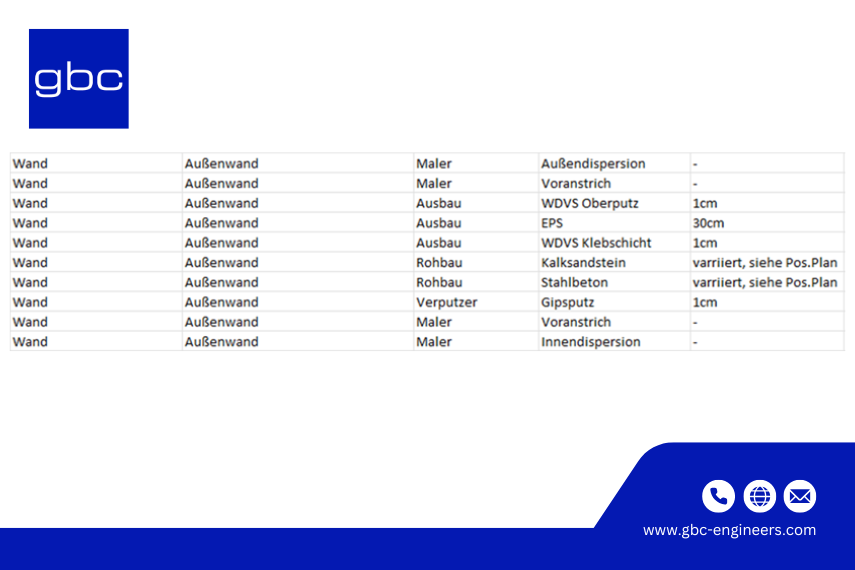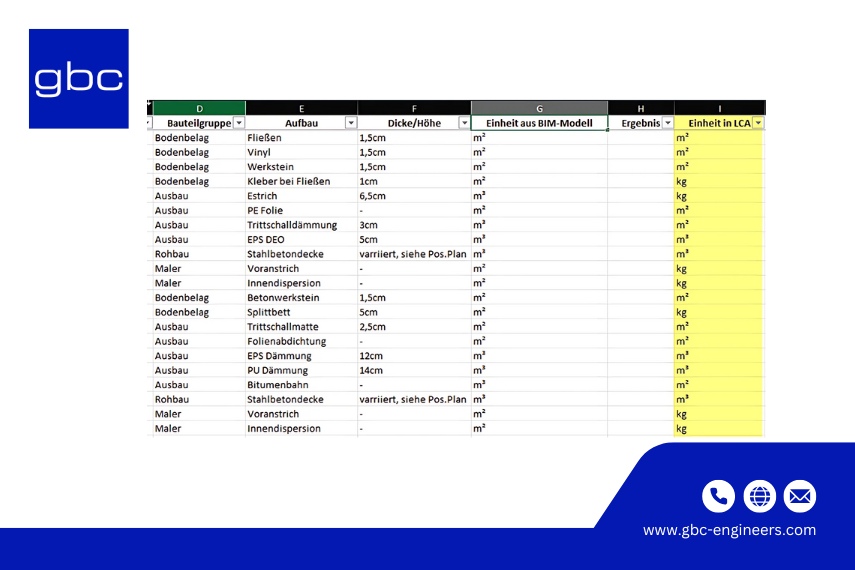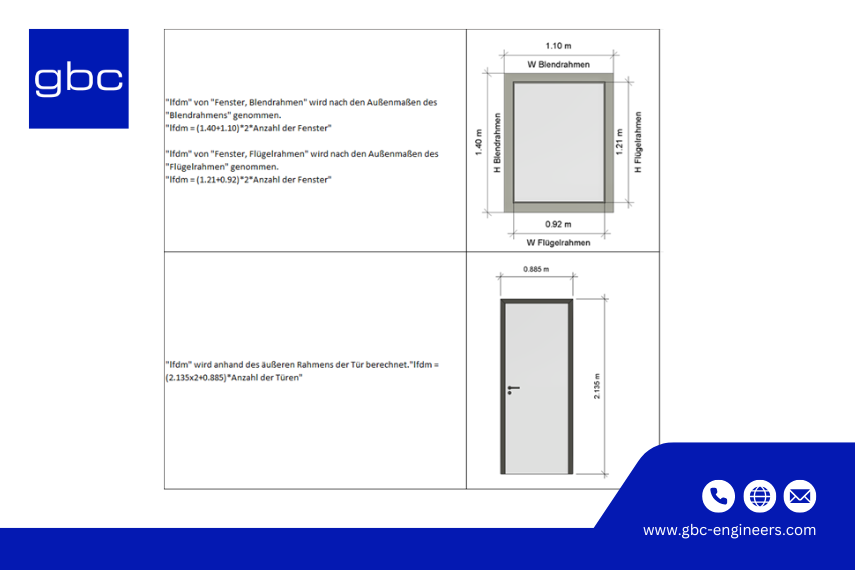Discover how Life Cycle Assessment (LCA) and BIM-driven quantity take-off empower sustainable construction, EPD integration, and green building compliance.
.png)
Integrating LCA into Structural Design: A Step-by-Step Approach
Life Cycle Assessment (LCA) has become an essential tool in sustainable structural design, helping project teams make data-driven decisions that minimize environmental impact from concept to construction. The LCA process follows a structured methodology divided into five key steps:
1. Define Goal and Scope:
This initial step involves identifying the purpose of the assessment, defining its functional equivalent, study period, and system boundaries. A clear definition ensures that LCA results are relevant and actionable for the building’s intended use.
2. Collect Inventory:
Detailed data is gathered on materials, energy usage, and construction processes throughout the building’s life cycle. Scenarios are developed to reflect different life cycle stages, capturing both net and gross amounts of resources.
3. Perform Impact Assessment:
Environmental Product Declarations (EPDs) and other verified data sources are used to calculate environmental indicators such as GWP (Global Warming Potential). This ensures consistency and reliability in quantifying environmental impacts.
4. Interpret Results:
The results are synthesized to derive meaningful conclusions, highlighting opportunities for reducing carbon footprint or improving resource efficiency.
5. Report and Verify:
Transparent communication of findings, data sources, and verification processes is crucial, especially when reporting to stakeholders or integrating results into project documentation.
LCA should not be treated as a standalone analysis but rather as an integrated design tool:
- Schematic Design (SD): Engineers and architects review carbon goals, compare structural systems (e.g., steel vs. wood), and optimize foundations based on LCA insights.
- Design Development (DD): Focus shifts to identifying carbon-intensive “hot spots” such as concrete use and developing strategies for material efficiency.
- Construction Documents (CD): Specifications are aligned with GWP targets, and materials with low environmental impact are selected.
- Bidding and Construction: The design team ensures that environmental targets are incorporated in bid requirements and construction practices, including updates to the LCA based on final material choices.
By embedding LCA throughout the design and construction process, project teams can not only comply with regulatory expectations but also deliver buildings with significantly lower environmental impact—positioning sustainability as a core design value, not just a checkbox.
Why LCA Matters Now
Sustainability in construction is no longer optional. With global regulations tightening and clients demanding transparency, Life Cycle Assessment (LCA) has become one of the most important tools in modern building projects. It provides a scientific method to measure the environmental impact of a building throughout its entire life cycle—from material extraction and production to construction, use, and eventual demolition.
For stakeholders across the value chain—developers, architects, engineers, and contractors—LCA delivers measurable data on carbon emissions, energy use, and material performance. It turns sustainability from a vague ambition into quantifiable results that drive both compliance and competitive advantage.

Understanding the Basics: What is LCA in Construction?
Life Cycle Assessment (LCA) evaluates the environmental footprint of a building by examining every stage:
• A1–A3: Raw material extraction and product manufacturing
• A4–A5: Transportation and construction phase
• B1–B7: Use, maintenance, and operation
• C1–C4: End-of-life, demolition, and waste treatment
• D: Benefits and credits from recycling or reuse
The strength of LCA lies in its ability to identify
carbon hotspots, those materials or processes that contribute most to the project’s embodied carbon. This insight enables design optimization, smarter material choices, and stronger bids for green building certifications such as
LEED, BREEAM, or DGNB.

The Role of EPDs: From Material Data to Project Insights
A crucial input for LCA is the Environmental Product Declaration (EPD). An EPD provides verified data about the environmental impact of a specific product, typically expressed as kilograms of CO₂ equivalent per kilogram or cubic meter of material.
However, while EPDs supply unit-level data, they cannot tell you the environmental footprint of an entire building. That requires Quantity Take-off (QTO): extracting precise material quantities from design models and multiplying them with the relevant EPD data.
In short: EPD + Quantity Take-off = Building LCA Report
Without QTO, an EPD remains a static document. With QTO, it becomes a powerful driver of decision-making, allowing clients to see the true environmental impact of a complete building.
BIM and Revit: Enabling Data-Rich LCA Workflows
This is where Building Information Modeling (BIM) tools, especially Autodesk Revit, come into play. While platforms like Allplan can generate drawings, Revit enables data-rich modeling, where every wall, slab, column, or window carries metadata that can be exported for LCA.
From best practice guidelines:
- Material labeling matters. Each family type should include explicit definitions (e.g., Concrete C30/37 instead of vague terms like “No Material”).
- Layered modeling is essential. Multi-material elements like walls and slabs must be modeled with all layers, including insulation and finishes.
- Parameters drive accuracy. Shared parameters such as Bauteilnummer, Bauteilart, Bauteilgruppe, Material density, Declared unit (m², m³, kg) enable automatic calculation.
- Reinforcement counts. Columns, beams, and slabs should include reinforcement details or documented ratios for realistic embodied carbon assessment.
- Avoid vague modeling. Hollow vs. solid elements must be defined correctly, while irrelevant decorative components should be excluded from LCA calculations.
This structured approach ensures that when a model is exported, the material quantities reflect reality and can be mapped directly to EPDs for reliable analysis.
The Workflow: From Client Drawings to LCA Report
Turning design data into an actionable LCA report involves a systematic workflow:
1. Input Data Collection
- Import architectural and structural drawings (plans, sections, details).
- Review technical specifications.
- Classify components according to client requirements (walls, slabs, beams, windows).
2. Revit Setup
- Create materials and family types with correct thickness and density.
- Define declared units consistently (m³, m², kg).
- Import IFC or DWG files from the client and align accurately.
3. Modeling Components
- Walls, slabs, beams, and columns are built with layered detail.
- Doors and windows include formulas for frame length and material weight.
- Railings and stairs require custom families to calculate total lengths and volumes
Quantity Take-off and Scheduling
- Generate schedules including material codes, groups, thickness, and quantities.
- Ensure density and classification fields are included for accuracy.
Export & Integration
- Export Revit schedules to Excel (using plugins such as DirootsOne).
- Map materials with the corresponding EPD.
- Transfer results into LCA software for carbon calculation.

Checking & Validation
- Verify naming conventions and avoid contradictions.
- Confirm reinforcement assumptions.
- Ensure hollow vs. solid elements are modeled correctly.
- Exclude non-relevant model parts from analysis.
Submission
- Deliver the final model and transparent LCA report.
- Provide both per-component results and a consolidated building footprint.
Why Clients Need LCA Reports
Even if clients already have EPDs, they rely on engineering consultants to:
- Extract quantities accurately from BIM models.
- Map materials properly to EPDs.
- Aggregate thousands of data points into a clear, project-wide LCA report.
This workflow turns fragmented information into decision-ready intelligence, enabling clients to benchmark designs, optimize materials, and demonstrate ESG compliance in investor reports and sustainability disclosures.
Case Example: BIM-Integrated LCA for Sustainable Projects
In practice, integrating LCA into BIM workflows can:
- Reveal that insulation layers contribute more CO₂ than expected, prompting a switch to low-carbon alternatives.
- Show that precast concrete panels outperform cast-in-place concrete when transport distances are short.
- Provide early-stage carbon analysis, enabling architects to refine material choices before construction begins.
For example, in one project, an IFC model was imported, rebuilt with layered Revit elements, and aligned with EPD data. The final report identified insulation as a major carbon hotspot. By switching to an alternative material, embodied CO₂ was reduced by 15%—a decision only possible with BIM-integrated LCA.
Benefits for Stakeholders
- Clients/Developers: Compliance with EU taxonomy, ESG transparency, stronger bids in green tenders.
- Architects/Designers: Data-driven design choices and the ability to compare design options (e.g., precast vs. cast-in-place).
- Contractors: Improved planning, reduced material waste, optimized procurement.
- Society: Lower embodied carbon and measurable contributions to climate neutrality.
Conclusion: LCA as the New Standard in Construction
Life Cycle Assessment is more than a compliance requirement. It is the bridge between design intent and measurable sustainability performance. By combining EPD data with precise BIM-based quantity take-off, engineers and architects can generate reports that not only meet client requirements but also drive innovation in sustainable construction.
In the coming years, LCA will shift from a “nice to have” to an industry baseline, and firms that adopt BIM-integrated LCA workflows today will set the standard for tomorrow’s sustainable projects. At this critical intersection, gbc engineers supports clients by providing accurate Quantity Take-off services from BIM models, ensuring that environmental data is reliable, transparent, and decision-ready. The future of construction belongs to those who can turn complex data into actionable sustainability strategies, and LCA, enabled by robust quantity take-off, is the language of that future.